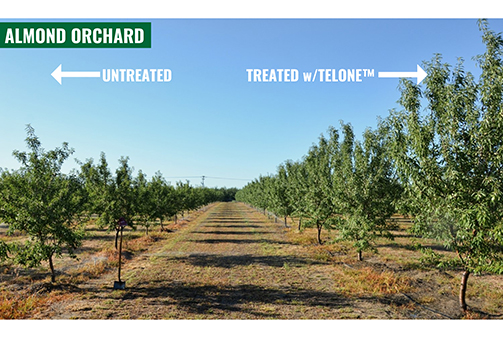Search Is On For Next Kink In Citrus Supply Line

Photo by Peter Chaires
There is clearly a trend toward improved scion and rootstock selections. Researchers are now exploring specific scion-rootstock combinations that appear to provide enhanced performance. Some nurseries are producing or ordering new rootstock liners from tissue culture. Hundreds of thousands of new liners are being produced from rooted cutting as a means of addressing the shortage of seed. However, time pressures and rapid progress on multiple fronts sometimes reveal a new weak link in the chain. For instance, it seems that while plant improvement innovations are moving us closer to the ultimate goal of trait-specific, high value tolerant trees, nursery production and process improvements may be necessary to rapidly and safely increase the availability of scion material.
Two UF/IFAS fruit displays have been held in Lake Alfred and one field day in Gainesville so far this season. Participants have been treated to promising high-color/great-flavored grapefruit, easy peel seedless tangerines, and many other unique hybrids, oranges, and acid fruits. The best fresh-market selections from these events will ultimately be directed to the FAST TRACK program. Processed oranges will be made available, though through a separate system. With so much Florida citrus acreage currently off-line, the right variety has the potential of unleashing demand. If any of these new selections are identified as candidates for large-scale planting, nurseries will have to determine the best way of producing large volumes of trees as rapidly as possible.
Up And Away
Rapid scale-up of scion material is a new challenge. Historically, varieties gradually entered the budwood and nursery systems. There was rarely a stampede for new scions and the industry’s natural aversion to risk allowed for increase of scion stock through traditional means. Today, any highly desirable new variety, with HLB tolerance or other economically significant improvements or potential, might quickly overwhelm existing scion production systems. Let’s quickly survey our options from 40,000 feet:
Traditional Budwood Increase
- As soon as clean material becomes available, DPI would establish sources trees at Chiefland and/or LaCrosse. Budwood increase would commence. If it is identified as a high industry priority, DPI would commit additional resources to this process. However, if millions of trees are required, simultaneous increase would be needed at the nursery level.
- Budwood would not be initially available to nurseries — but they would be supplied by DPI as soon as possible.
- Rapid scion budwood screenhouses are not currently dedicated to this purpose.
- This would be a two- to three-year process under the best of circumstances.
Tissue Culture Scion Production And Micro-Grafting To Tissue Culture Or Rooted Cutting Liner Plantlets
- Use tissue culture to produce a large volume of scion material.
- Micro-propagation would pare small micro buds (slivers) of the scion with small, two-inch rootstock plantlets then grown-out in growth chambers, acclimated, and transplanted to larger pots.
- Though tissue culture production starts slow, a large volume of material can be produced in 12 to 15 months.
- Micro-propagation is an intensive process that requires special skill. One tissue culture lab stated that in the time it takes a nursery to produce 3,000 to 3,500 trees by traditional grafting, they could produce roughly 500 trees from micro-propagation. This figure may improve with experience and improved procedures.
- Some have expressed concern that the bud-take will be lower, making large-scale production of commercial finished trees a challenge. There is no consensus on this.
- There is concern about variability and trueness to type when using this technology. However, Dr. Fred Gmitter, UF/IFAS- CREC, reminds us that variation also is a possibility — even with standard propagation methods; just consider all the various clones of Hamlin, Valencia, etc. He goes on to explain there may be two risks here. First, the risk of variation already mentioned, of course, but second, the risk of losing time by being more conservative in budwood increase. If we’re trying to get something out quickly to begin to capture a market, then the risk of waiting longer may outweigh the other. This is a process we’d want to employ to quickly increase materials for new tree production, but afterward it may be sensible to transition to a more conservative traditional approach.
Scion Plant Material From Tissue Culture Budded To A Standard-Sized Liner
- This method would start out the same way as with micro-propagation. Scion plant material would be produced from tissue culture. This material would be micro-propagated to small, two-inch rootstock plantlets.
- However, rather than these plants being the final product, they would be transplanted and used for budwood increase. Through this process, hundreds of thousands of buds could be produced in one year and perhaps more than a million in 18 to 24 months. The normal-sized budwood produced from this process would be budded to traditional sized rootstock liners.
- Again, a slow start — but then production would increase exponentially.
- Same challenges with variability and trueness to type exist.
- This method would reportedly produce better bud-take and efficiencies. This may be our most likely route in the future.
Driven To Grow
The good news is that nurseries are exploring and embracing ways to address the shortage of rootstock liners. These liners will soon be available for production of varieties for which ample budwood is available. However, the fact remains that Florida is playing catch-up on methods of rapidly producing large volumes of scion material of new promising selections.
This may require the innovation of the nursery segment paired with the scientific research community. For the time being, a good option appears to be the release of budwood to interested nurseries as early in the process as possible. Nurseries driven by self-assessment of scion potential and customer input will make the difficult decision of how/where to commit resources. Because nursery commitments flow from grower commitments, communication between nursery and grower remains critically important.
Homework Assignment
While expanded DPI screenhouse capacity should help fuel larger-scale budwood increase, the Citrus Budwood Technical Advisory Committee (CBTAC) and DPI should explore ways of freeing-up capacity to generate more plant material from newly processed scion selections. Likewise, the industry must identify a more effective means of prioritizing scion candidates. DPI should not be in the unenviable position of doing this. Processed and fresh interests should be represented in this process. The New Varieties Development & Management Corp. Board is certainly a diverse and informed group and can feed into this effort, but the conversation starts at the CBTAC.










